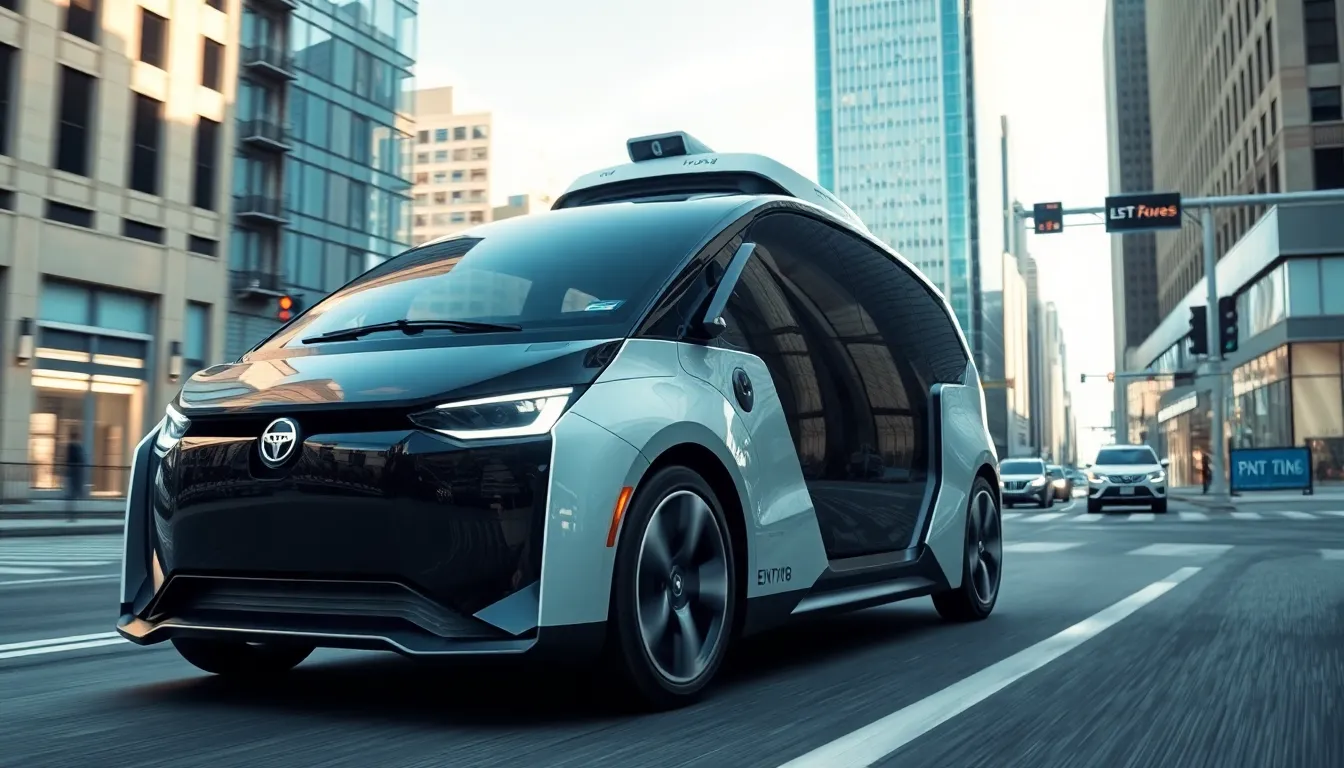The rise of autonomous vehicles marks a revolutionary shift in transportation. These self-driving cars promise to redefine how people commute, enhancing safety and efficiency on the roads. With advancements in artificial intelligence and sensor technology, they’re not just a futuristic dream; they’re becoming a reality faster than many anticipated.
As cities evolve and traffic congestion worsens, the need for innovative solutions grows. Autonomous vehicles offer a glimpse into a world where human error is minimized, and mobility becomes more accessible for everyone. The implications of this technology extend far beyond personal convenience, potentially transforming urban planning, environmental impact, and economic structures.
Table of Contents
ToggleOverview of Autonomous Vehicles
Autonomous vehicles, also known as self-driving cars, utilize advanced technologies to navigate without human intervention. These vehicles operate using a combination of artificial intelligence, machine learning, and various sensors, including LiDAR, radar, and cameras. Understanding the levels of automation helps clarify the capabilities of these systems.
Levels of Automation
- Level 0: No automation; human controls every aspect of driving.
- Level 1: Driver assistance; features like adaptive cruise control support human drivers.
- Level 2: Partial automation; the vehicle can control steering and acceleration simultaneously but requires human supervision.
- Level 3: Conditional automation; the vehicle handles most driving tasks but expects human intervention when necessary.
- Level 4: High automation; the vehicle can operate independently in certain conditions, like urban areas or highways.
- Level 5: Full automation; the vehicle operates without human input in all scenarios.
Key Technologies
Autonomous vehicles rely on crucial technologies for navigation and safety:
- Artificial Intelligence: AI algorithms process data from sensors, enabling the vehicle to make real-time decisions.
- Sensors: LiDAR, cameras, and radar provide data regarding the vehicle’s surroundings, including road conditions and obstacles.
- Connectivity: Vehicle-to-everything (V2X) communication enhances safety by allowing vehicles to share information about traffic signals, road hazards, and other vehicles.
Applications of Autonomous Vehicles
Autonomous vehicles have potential applications across various sectors:
- Public Transportation: Self-driving buses can enhance commuter efficiency and reduce operational costs.
- Freight and Delivery: Autonomous trucks and delivery drones can lower transportation costs and optimize supply chains.
- Personal Vehicles: Self-driving cars promise increased comfort and improved accessibility for those unable to drive.
Regulatory Landscape
The regulatory environment surrounding autonomous vehicles evolves rapidly. Governments worldwide are drafting regulations to ensure safety while promoting innovation. Countries like the United States, Germany, and Japan are testing and implementing frameworks for autonomous vehicle integration into existing infrastructures.
Future Prospects
The future of autonomous vehicles looks promising, with continuous advancements in technology. Industry experts predict widespread adoption within the next decade, leading to significant changes in daily commuting, urban planning, and economic systems. The ongoing development aims to create safer, more efficient transportation solutions that align with sustainability goals.
Technology Behind Autonomous Vehicles

Autonomous vehicles rely on a combination of advanced technologies that work together to achieve safe and effective self-driving capabilities. Key components include sensors, cameras, and machine learning algorithms, which play crucial roles in navigation and decision-making.
Sensors and Cameras
Sensors and cameras form the backbone of autonomous vehicle systems. Various types of sensors enhance environmental awareness by detecting obstacles and measuring distances. Common sensors include:
- LiDAR: Uses laser pulses to create a detailed 3D map of surroundings, enabling precise object detection.
- Radar: Provides reliable detection of objects at various distances, especially in adverse weather conditions.
- Cameras: Capture high-resolution images for visual recognition and lane detection, allowing for real-time assessment of the driving environment.
These technologies collectively support advanced perception, helping vehicles navigate complex scenarios accurately and efficiently.
Machine Learning Algorithms
Machine learning algorithms empower autonomous vehicles by processing vast amounts of data gathered from sensors and cameras. These algorithms enhance decision-making through:
- Real-Time Data Processing: Analyzing data instantly to identify patterns and make navigation decisions during driving scenarios.
- Predictive Modeling: Anticipating the actions of other road users, such as pedestrians and other vehicles, ensuring safer driving responses.
- Continuous Learning: Updating algorithms over time based on new data, improving performance and safety through experiences from numerous driving scenarios.
Machine learning significantly contributes to the evolution of autonomous vehicle technology, fostering increased reliability and efficiency.
Benefits of Autonomous Vehicles
Autonomous vehicles offer numerous advantages that enhance safety, efficiency, and accessibility in transportation. These benefits significantly impact daily commuting and broader urban planning efforts.
Safety Improvements
Autonomous vehicles employ advanced technologies to minimize accidents caused by human error. According to the National Highway Traffic Safety Administration (NHTSA), 94% of serious crashes result from human mistakes. Self-driving systems utilize sensors, cameras, and LiDAR to monitor surroundings, ensuring a comprehensive understanding of road conditions. These vehicles can react to stimuli much faster than human drivers, consistently maintaining safe distances and adhering to traffic rules. Furthermore, their ability to predict and respond to potential hazards contributes to a significant decrease in accidents and pedestrian injuries.
Traffic Efficiency
Autonomous vehicles boost traffic efficiency by optimizing driving patterns. They communicate with each other and infrastructure through vehicle-to-everything (V2X) technology, allowing for coordinated movements in real-time. This connectivity reduces congestion and enables smoother traffic flow, decreasing travel times for commuters. The American Journal of Transportation reports that widespread adoption of autonomous vehicles could reduce traffic jams by 30%, leading to more efficient use of roadways. Such enhancements not only improve individual commutes but also alleviate pressure on urban infrastructure, allowing for better overall management of city resources.
Challenges Facing Autonomous Vehicles
Autonomous vehicles encounter several significant challenges that could hinder their widespread adoption. Key issues include ethical considerations and legal as well as regulatory hurdles that need addressing to ensure safe integration into society.
Ethical Considerations
Ethical dilemmas arise when programming autonomous vehicles to make critical decisions in emergencies. Scenarios such as determining whom to protect in unavoidable accidents pose serious ethical questions. Manufacturers grapple with how to encode moral values into algorithms while ensuring compliance with varying cultural norms. Developers must strikingly balance safety and risk management, as ethically charged circumstances may require quick, life-altering choices.
Legal and Regulatory Issues
Legal frameworks for autonomous vehicles are still evolving. Regulation varies widely across regions, complicating deployment. Legal liabilities in accidents involving autonomous cars raise questions about responsibility—whether it rests with the vehicle manufacturer, software developer, or vehicle owner. Comprehensive legislation that encompasses liability, insurance, and safety standards remains essential. Governments must adapt existing traffic laws to accommodate self-driving technologies and establish guidelines that promote safe operation without stifling innovation.
Future of Autonomous Vehicles
The future of autonomous vehicles promises significant advancements and transformations in transportation. Stakeholders anticipate increased adoption driven by improved safety, efficiency, and convenience. Experts project that the integration of autonomous vehicles in urban areas could reshape commuting patterns, reduce traffic congestion, and enhance overall mobility.
Innovations in artificial intelligence and machine learning will continue to enhance vehicle performance. Enhanced algorithms will allow vehicles to process vast amounts of data, making decisions in real-time with greater accuracy and reliability. Continuous learning mechanisms will ensure that vehicles adapt to new environments and evolving traffic scenarios, leading to more sophisticated navigation capabilities.
Infrastructure improvements will play a crucial role in the future of autonomous vehicles. Smart traffic signals, dedicated lanes, and enhanced communication systems are expected to complement self-driving technology. Vehicle-to-everything (V2X) communication will enable seamless interaction between autonomous vehicles and urban infrastructure, optimizing traffic flow and reducing wait times at intersections.
Regulatory frameworks are also poised to evolve in response to the growing presence of autonomous vehicles. Governments worldwide are drafting comprehensive legislation that addresses safety standards, liability, and insurance requirements. These regulations aim for a balance between fostering innovation and maintaining public safety, facilitating a smoother transition to autonomous mobility.
The economic impact of widespread autonomous vehicle adoption may be profound. Increased efficiency in public transportation and logistics could lead to cost savings for businesses and governments. Job displacement in certain sectors must be addressed, ensuring that workforce development programs prepare individuals for new opportunities arising from this technological shift.
Environmental benefits from autonomous vehicles also warrant attention. Optimized driving patterns and reduced traffic congestion may contribute to lower emissions, aligning with global sustainability goals. As these vehicles gain traction, stakeholders can expect significant reductions in fossil fuel consumption and improvements in air quality.
By aligning technological, regulatory, economic, and environmental factors, the future of autonomous vehicles holds the potential for a safer, more efficient, and sustainable transportation system. Organizations and governments must work together to navigate challenges while maximizing the benefits that come with this breakthrough in mobility.
The journey towards widespread adoption of autonomous vehicles is just beginning. As technology advances and regulatory frameworks evolve, the potential for safer and more efficient transportation systems becomes increasingly tangible.
Stakeholders must navigate the challenges of ethics and legislation while harnessing the benefits of AI and machine learning. With the right approach, autonomous vehicles can revolutionize urban mobility, reduce congestion, and enhance accessibility for all.
The future of transportation is on the horizon, promising a transformative shift that could redefine how people and goods move in our cities. Embracing this change will be crucial for building a sustainable and efficient transportation landscape.




